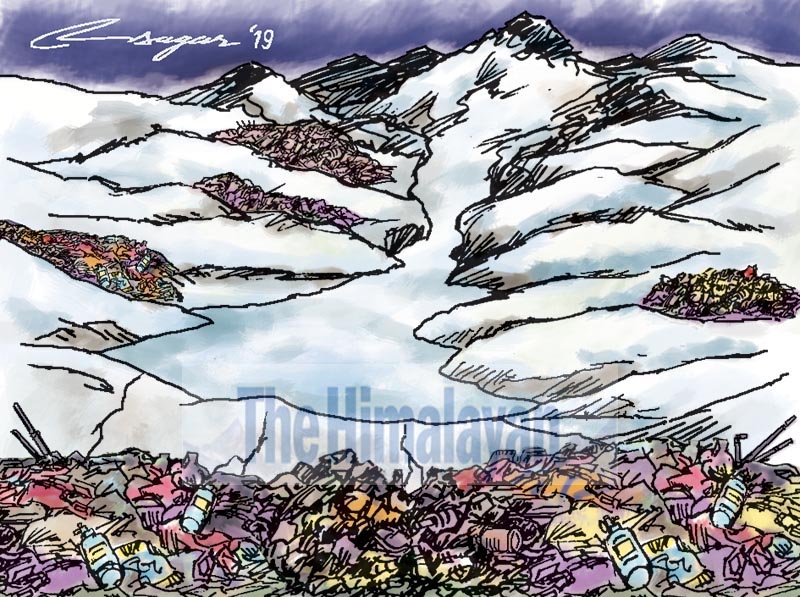Himalayan ecology at risk: Global warming heightens it
While the effects of global warming on the Himalayan region are the central issue when discussing dangers to mountain ecology, there are other issues that threaten life in the mountains, and these concern environment degradation by man
There is no denying that Nepal is a magnet for mountaineers the world over, simply because of Mount Everest, the ascent of which is the ultimate test for any climber, along with seven of the other 14 highest peaks. The Himalayas feature prominently in the world’s media, particularly when the climbing season comes around (the month of May, especially, when all summits of Everest are attempted).
However, the media coverage isn’t always for the right reasons; currently, it’s more bad than good, despite record numbers of climbers achieving success, and new records being made. Tragedy has struck in the high Himalayas once again, with a significant number of deaths. While overcrowding has been pointed out as one of the reasons, one could also blame the fickle weather gods, as well as the unpreparedness of the climbers.
In the past, too, some headlines have been really bad, such as this one dated May 20, 2014: “Global Warming Threatens More Deadly Everest-Like Avalanches”, which stated “mountaineering tourism in Nepal faces a threat from global warming as melting glaciers feed the risk of more deadly disasters such as the avalanche on Mount Everest that killed 16 people last month.”
Global warming vis-à-vis the Himalayas has always been a much-bandied-about subject. No one doubts the effects of global warming on the fragile Himalayan ecosystem. To recapitulate, the Himalayas stretch for some 3,500 km from Afghanistan to South China, covering a surface area of over 1,000,000 square kilometres. Of this vast chain of mountains, the central part, consisting of 800 km, lies in Nepali territory, and it has over 1,300 peaks of 6,000 m and above, including eight of the world’s 14 tallest peaks. Thus, whatever happens to this part of the Himalayas will surely have significant effect on the rest of the world. These icy peaks are an inherent part of this country’s ecosystem, which is actually very diverse, ranging from 70 m in the Terai to 8,848 m in the Himalayas across a short distance of only about 75 km. Numerous ethnicities, cultures and lifestyles add to the interesting diversity.
Coming back to global warming and the ecology of the Himalayas, it has been in the spotlight for a long time now. The effects of global warming are quite obvious today; mountaineers say that one can observe many more rocks now, in contrast to the virgin cover of snow in the days gone by. This implies that the meltdown of snow is occurring faster now, and as per the experts, while over 3,000 glaciers have been recorded in the region in the past, an equal number of glacial lakes have been formed over the last century. Therefore, the risk of glacial lake outbursts has increased many times now.
Similarly, the rapid melting of mountain snow has increased the risk of avalanches and rock-falls, which naturally does not bode well for trekkers and mountaineers. Climbers, especially, are coming across substantially more exposed rocks on climbing routes, which make them difficult to hike on, and of course, necessitates more energy to traverse through. Thus, nowadays, climbers have to be all the more proficient in their mountaineering skills, which unfortunately is not the case, what with increasing commercialisation of the mountains and people’s quest for easy glory.
While the effects of global warming on the Himalayan region are the central issue when discussing dangers to mountain ecology, there are other issues, as well, that threaten life in the mountains, and these concern environment degradation by man. The Himalayas are a magnet for people looking for adventure from around the globe, and so there are ever-increasing numbers attempting to climb different peaks every climbing season.
Likewise, trekkers too are on the rise, with additional new trails offering more novelty and challenge. Both trekkers and climbers are accompanied by porters and guides, and every expedition is time-consuming, with routes requiring many days to be navigated. This means many nights of camping on the way, which naturally means that a lot of firewood is used. This means that the forests too are threatened, and thus deforestation could be very much an outcome.
Doubtless, mountain tourism is an important part of tourism here, but it could also result in depletion of forests because of the rampant use of forest wood. As it is, many Himalayan flora and fauna are already rare and endangered, and now the danger increases all the more due to human transgressions. And naturally, deforestation further decreases their chances of surviving.
Overcrowding in camp sites is another issue, resulting in waste and garbage disposal problems. Complaints about empty bottles, plastic materials and aluminum cans littering the trails are common. So much so, that garbage accumulation on Everest has often featured prominently in global media, prompting some to organise clean-up campaigns.
For example, in 2011, Everest Summiteers’ Association’s “Save the Everest Mission” collected about 8.1 tons of garbage from Everest and its trails! Well, to conclude, the signs are clear that the fragile ecology of the Himalayas is at great risk, and it is equally clear that cleaning up after the act is not always a possibility. Now, if you add global warming to this scenario, it depicts a very dangerous picture of the fragile Himalayan ecosystem, indeed.






